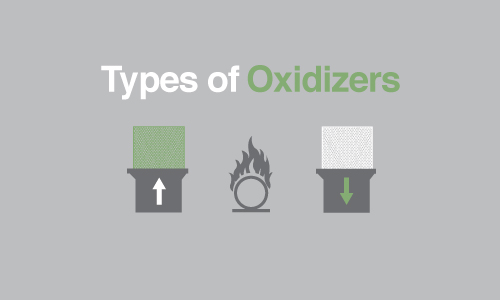Oxidizers are used to eliminate harmful pollutants emitted during the manufacturing process. There are various control systems available, each with slightly different operating procedures and requirements. Facility owners must consider which system not only works best with their production budgets but helps them meet all compliance regulations set by the EPA.
Furthermore, characteristics within each exhaust stream dictate what type of oxidizer is best suited for the job. Manufacturers must consider pollutant type, pollutant concentration, airflow volume, and airflow temperature when selecting a control unit.
Types of Oxidizers
There are two types of oxidizing control systems: catalytic and thermal.
Thermal oxidizers work by heating incoming VOC and HAP streams to very high temperatures, destroying the particles through the process of oxidation. These systems typically require natural gas to heat the combustion chamber to the required temperature.
In contrast, catalytic oxidizers use materials to accelerate the combustion process at lower temperatures. This system can be fueled using various energy sources. It’s worth noting that certain materials, silicone, sulfur, and heavy metals can contaminate the catalytic bed and hinder the combustion process.
Direct, Recuperative, or Regenerative Heating Systems
The way each control unit generates heat impacts fuel costs and combustion results, which are unique to each plant. Direct, recuperative, and regenerative heating systems can be used in both thermal and catalytic models.
- Direct oxidizers are simpler in design, using one fuel source to heat the combustion chamber. While these units are typically less expensive and easier to install, the heat generated by the combustion process is not re-captured. Therefore, incoming exhaust streams must be heated from the original inlet temperature. Due to the increased amount of fuel required to heat these systems, they are not usually recommended for exhaust streams with large air volumes.
- Recuperative oxidizers use the energy generated by the purified gas to preheat the incoming airflow, reducing the amount of fuel needed for each application. By circulating the heat, recuperative systems can reuse up to 70 percent of the energy otherwise lost during operation. Exhaust streams with higher pollutant levels and airflows of 30,000 SCFM can be successfully applied to this type of oxidizer.
- Regenerative oxidizers are constructed using several ceramic beds that retain heat during oxidation and transfer energy to surrounding beds for continued use. It is estimated that 97 percent of the energy produced by regenerative oxidizers is saved and redistributed using this system. Regenerative oxidizers can be used for a variety of exhaust streams, including high air volumes and halogen concentrates.
Cost Considerations
The cost of each device must be considered alongside the effectiveness of the machine’s VOC and HAP destruction rate. The material used in catalytic oxidizers could require replacement every three to four years to maintain efficiency. Therefore, the cost of the replacements may outweigh the benefits of a catalytic oxidizer.
Regenerative systems are heavier, larger, and more expensive to install but save manufacturers money on fuel consumption. If your plant emits higher volumes of pollutants, the costs required upfront may be offset by the savings generated from lower fuel costs.
In contrast, if your plant does not require VOC abatement for long periods of time, the cost of adding a recuperative heat exchanger may not be enough to offset the overall benefits of using less fuel.




